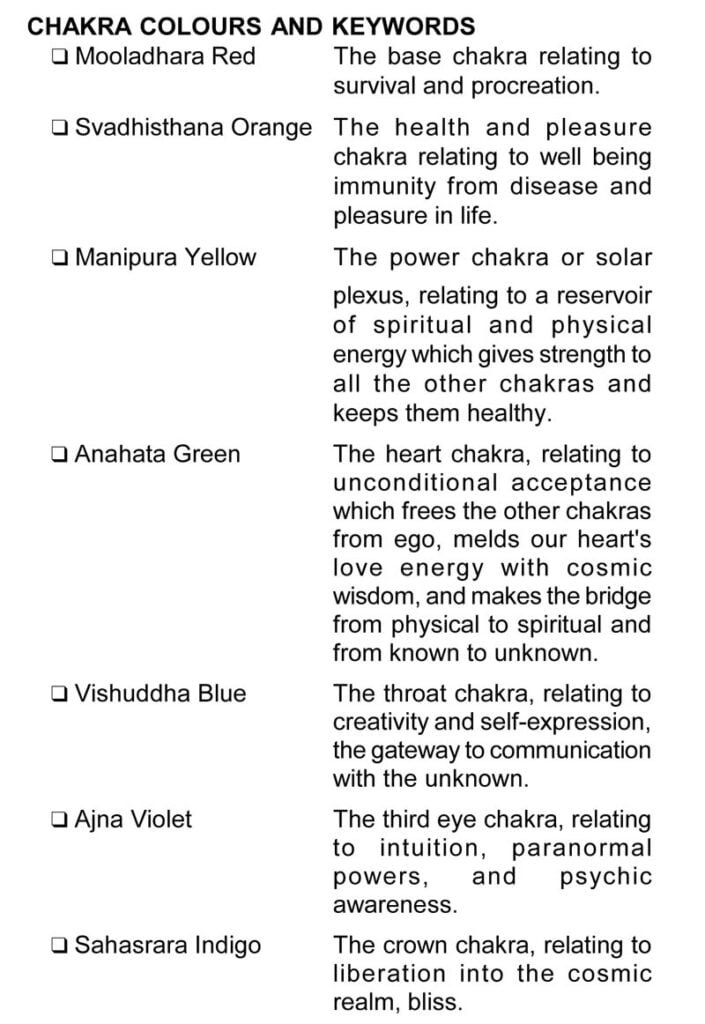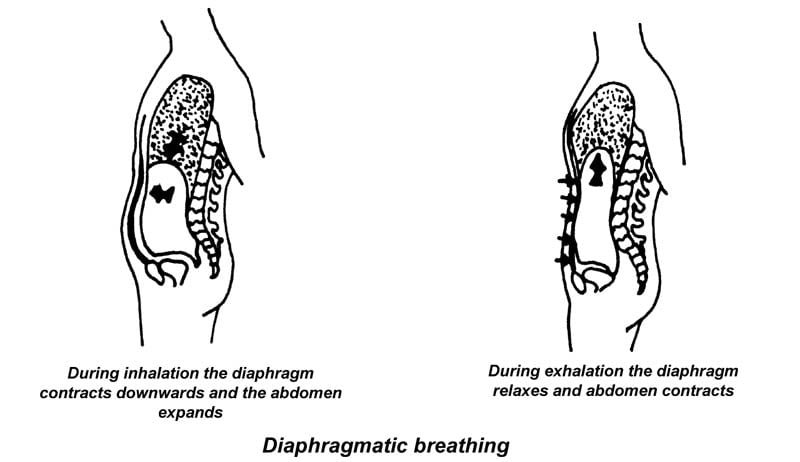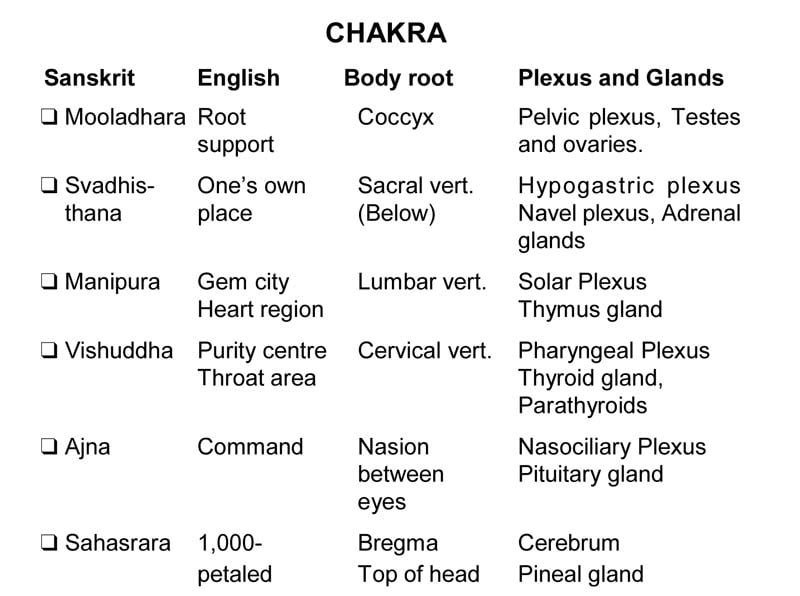Everything is energy. You can facilitate the entrance of energy into your body through the top of your head. Here is one way to start learning how to consciously absorb the life force:
Sit quietly and close your eyes. Imagine warm white or blue light glowing about six inches above the top of your head. Open your head to receive the light, which flows down your legs, down your arms, and out of you. Then become filled to overflowing simply by closing your fingers and toes so the Chi builds inside you. Become saturated, even to the outside of your aura, the field of energy that surrounds every organism. Become replete with energy. Take your time. Then let the light grow until it surrounds you. Notice how you feel. When you are ready open your eyes. The protection of the light will remain with you.
Chakras: Spinning Energy wheels
For thousands of years, Eastern philosophers have believed that the human organism gets most of its energy from invisible waves or rays entering through the top of the head. Every parent knows the soft spot on a baby’s head, the fontanelle, must be protected for the child’s first months of life. The bones of the skull naturally close this opening with age, to protect the delicate brain tissues. Just as this opening is though to have received energy from the mother while she holds her child in the womb, Eastern tradition teaches that the crown of the head remains the primary

5. Vishuddha, 6.Ajna, 7. Sahasrara, 8. Lao Kun, 9. Yung Chuan
The Chakras
entrance place of vital chi throughout life. In addition, significant amounts of Chi also come up through the spine and through the feet, from Mother Earth.
As the life force enters the body, it passes through and activates the seven primary chakras. The word chakra means wheel, ‘and is an ancient East Indian symbol, used in this sense to mean a centre of physical and psychic energy. The seven major chakras are known by many different names. We prefer the East Indian terms.
1. Mooladhara, 2. Svadhisthana, 3. Manipura, 4. Anahata, 5. Vishuddha, 6. Ajna, 7. Sahasrara
Also indicated on the accompanying chakra diagram are two secondary chakras. We like to call the palm chakra (8) by its Chinese name, Lao Kun, and we refer to the chakra in the soles of the feet (9) as Yung Chuan, ‘Bubbling Spring.’
There are, of course, many other energy points and junctions along the energy meridians (which correspond to our nervous system) which lace our bodies. The acupuncturist uses these points to cure illness and relieve pain.
The major chakras are located along the spinal column, and are closely related to the endocrine system, the nervous system, and the circulatory system, all of which influence hormonal secretions in some way. The accompanying illustration shows approximately where the chakras are located, and you can see for yourself how they relate to the diagrams of body systems.
At the peak of health and vitality, our chakras spin or vibrate at great speed. As we grow older or develop unhealthy habits and begin to lose vitality, the rate of vibration of some or all of the chakras slows down. This gradual decrease in vibration affects the flow of hormones released by the endocrine system. Too much, too little—either condition brings on the familiar symptoms of aging, and also increases the possibility of disease.
Your task is to mix and balance the incoming energy, the earth energy, with the energy coming in from the universe, and to create a system of chakras that literally ‘hums’ If balance occurs, each chakra will be open, the physical body will perform optimally, and a unified organism will result.
Are you ‘In the Pink’?
When concentrating on the different chakra centres of your body, you may see certain colours when your eyes are closed. Once your goals become more spiritual, you may feel drawn toward particular colours, depending on the chakra you are working with. It is all a matter of what feels right to you at each particular stage of your spiritual development.
Rainbow colours are almost universally accepted to represent the chakra centers, although there is not such agreement as to which color symbolizes which chakra. But this does not point to one being right and one being wrong, rather, it points to the difference in what color was seen by a particular master while in meditation.
The number of light waves that come to our eyes each second is known as the frequency of light. The different frequencies are perceived as different colors. The red end of the light spectrum or rainbow, is the lowest frequency of light waves. The blue end is the highest frequency.
And, of course, light is not the only thing that has a frequency because it is composed of waves of energy. All parts of the universe, flesh and blood, plant and mineral vibrate because each is a different form of energy. Our chakras are concentrations of energy which seem to have their own integrity and their own separate identity and frequency. You can ‘Feel’ someone behind you without actually hearing, seeing or noticing him or her in any way other than identifying a field of energy that is vibrating a bit differently than your energy body.
We are presenting the colour scheme and key words we are most comfortable with, based on the colors our energy work has shown us. You can adapt it according to what colours you identify with when working with each chakra.

Develop Patience
People in the West are competitive and impatient, attributes which do not promote spiritual development. They want to work in the stars because it sounds more interesting, more exciting; it is something new and different. English words tend to give false impressions, because of how they use the same works in everyday life. Without thinking about it, they want to rush on to do ‘advanced work’ because it must be more important than ‘beginning work’ And, of course, violet is a royal colour and must therefore be more deserving of our concentration than plain old red.
It is important not to make the mistake of confusing the terms ‘higher’ and ‘better.’ Mooladhara, Svadhisthana and Manipura are known as the earth-based chakras. Vishudha, Ajna, and Sahasrara are the cosmic chakra. Right now, most of us are living in the physical plane and our firm foundation, our base, is very well developed. But the earth based chakras all need nourishment and attention. At the same time that you are developing the chakras that are symbolically higher in the body and which deal more with the spiritual aspects of life, give your three lower chakras nourishment. Try not to forget that while we are on the physical plane. Even though our heads may be in the clouds, our feet are still on the ground.
The Breath Cleansing Technique
This is best done in a kneeling position in which you can bend forward freely. Place your hands on your stomach, left hand over right, just underneath your rib cage, Bend forward and gently press out all the air by pulling in with your hands and expelling all the air in your lungs.

Then, take a complete breath in about six or seven good, sized sniffs, going back each time until you are sitting upright your lungs fill, your stomach will push outward, and your on your heels. Your diaphragm will expand down ward as rib cage will come up. Don’t hold this large breath more than a few seconds. Release it explosively, all at once, through your nose.
Assist the rapid and complete cleansing by pulling in with your hands and by leaning forward as you exhale to get all the air out.
Up to seven cleaning breaths can be done at one sitting. This cleansing breath technique is beneficial to anyone, but especially for those exposed to a polluted environment (which does include most of us.).
The following technique is a breath balance which can be performed before any exercise.
Nadi Shodhana
The purpose of this “breath of union” is for you to begin to breathe equally through both nostrils. It is an effective technique for balancing the energy in your body and the two hemispheres of your brain, to help you attain a more balanced state of awareness.
To begin, sit on the floor, cross-legged if possible or in another comfortable meditation posture. Your left hand, with thumb and index fingers joined, rests on your left knee. The index finger of your right hand rests on your forehead, between your eyebrows at the third eye chakra. The thumb of your right hand will be used to close your right nostril and the middle finger will close your left nostril.
You will probably be breathing through one nostril more than the other. For the purpose of these instructions, we will call the right nostril the dominant one. If you find you are breathing more from the left nostril, begin the breathing sequence in reverse of what we describe, starting out with your left hand closing your nostrils, and so on.
To begin Nadi Shodhana, inhale and press your right nostril (or whichever is your dominant nostril) closed with your right thumb and exhale forcefully through your left nostril. Inhale through your left nostril as you count to seven. Now close your left nostril with your middle finger of your right hand and hold your breath again for a count of seven.
Release your right nostril and exhale through it for a count of seven. Immediately, still keeping your left nostril closed, inhale slowly through your right nostril for a count of seven. Assume Moola bandha as you make this slow inhalation. After you count to seven, close both nostrils and hold your breath for another count of seven. Now release the left nostril and exhale through your left nostril for a count of seven, releasing Moola bandha as you do so.

Repeat the entire sequence seven times in all. Remember, do not hold your breath if you have high blood pressure. You will gain a balancing benefit from this technique.

